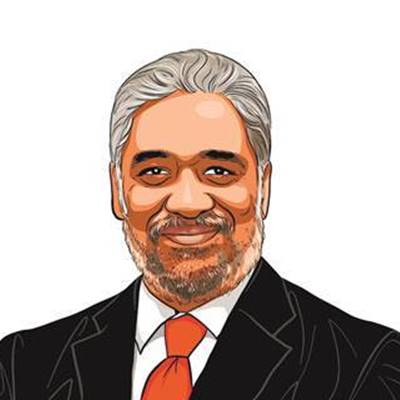Opinion C Raja Mohan writes: India, US and the atomic second wind
The enduring convergence of objective interests between Delhi and Washington and the long record of political commitment for deeper cooperation in advanced technologies does not mean it will automatically continue under Trump. Sustaining India-US high-tech cooperation demands continuing efforts.
 Despite the non-proliferation challenge, Prime Ministers Indira Gandhi and Rajiv Gandhi sought to find some common technological ground with the US during the 1980s. (Illustration by C R Sasikumar)
Despite the non-proliferation challenge, Prime Ministers Indira Gandhi and Rajiv Gandhi sought to find some common technological ground with the US during the 1980s. (Illustration by C R Sasikumar) The US National Security Advisor Jake Sullivan’s visit to India — the last of his foreign visits as the top official of President Joe Biden’s security establishment — highlights three important features of the bilateral relationship. First is the expansive commitment of the Biden Administration — including the special contribution of Sullivan and his team at the White House — to take the relationship with India to a higher level and the determination to prevent unanticipated crises from derailing the India-US strategic partnership.
Second, is the special effort by the Biden Administration to deepen advanced technology cooperation between the two nations. The Biden Administration has gone beyond the phase of government-to-government engagement on tech issues and launched a new era of techno-industrial collaboration in sectors like AI, semiconductors, space, and biotechnology that are set to dominate the global economy this decade and beyond. This has involved drawing in industry, start-ups and research communities from both sides.
The policy instrument for this has been the initiative on Critical and Emerging Technologies (iCET) that was unveiled by Sullivan and the Indian National Security Adviser, Ajit Doval, in January 2023. The iCET has involved massive and detailed negotiations on a range of complicated issues and several difficult bureaucracies in Delhi and Washington. It will endure as an important legacy of the Biden years for India-US relations.
The iCET is at the very heart of Biden’s larger strategy. It seeks to rearrange the global economy by derisking from the massive dependence on China that emerged over the last four decades, build new technology partnerships with allies and partners, and create a structure of regional balance of power in the Indo-Pacific that will limit the Chinese dominance in Asia and its waters.
Technology has been at the heart of modern India’s imagination of America since the late 19th century. It became the central focus of independent India’s engagement with the US. America played a key role in the early development of India’s nuclear and space programmes. It was a critical factor in modernising India’s agriculture and contributed to the development of scientific and technological education.
If the early decades of independence saw expansive bilateral cooperation in technology, the 1970s saw the collapse of that cooperation, thanks to the new non-proliferation laws that came into force in the United States and new global norms on preventing the spread of nuclear weapons.
By remaining a non-nuclear power in the 1960s, Delhi made itself a target of the expansive sanctions that were unleashed by the US and the advanced industrial powers, including the Soviet Union in the name of non-proliferation. (Legend has it that US President John F Kennedy had offered to help India build nuclear weapons in the early 1960s, but Prime Minister Jawaharlal Nehru declined the offer.)
Despite the non-proliferation challenge, Prime Ministers Indira Gandhi and Rajiv Gandhi sought to find some common technological ground with the US during the 1980s. But the 1990s saw a strengthening of the non-proliferation controls against India. Atal Bihari Vajpayee’s nuclear tests of May 1998 provided a new basis for India-US engagement and a big push to resolve the nuclear and related technological disputes.
The breakthrough came with the India-US civil nuclear initiative that was negotiated between President George W Bush and Prime Minister Manmohan Singh during 2005-08. In Washington, Barack Obama and Donald Trump have continued to clear the ground for deeper technological cooperation. Biden and Prime Minister Narendra Modi have taken it to a whole new level with the iCET.
Despite much progress, there have been lingering issues preventing the full realisation of the benefits of the excellent progress in tech cooperation over the last two decades. In Delhi, Sullivan announced on Monday that several existing restrictions on civilian space cooperation with India are being lifted. He also cited continuing work in the Biden Administration to remove key atomic energy centres in India from the US black list to facilitate bilateral civilian nuclear energy cooperation. (President Biden and the executive branch can make policy decisions right up to January 19, and they are being made every day).
India too has work to do — especially in modifying the provisions of The Civil Liability for Nuclear Damage Act, 2010 that have prevented US and Indian companies from investing in the nuclear energy sector. It’s indeed a pity that nearly 20 years after the nuclear deal was unveiled, there have been no deals to build nuclear power plants with international suppliers other than Russia.
Policymakers in Delhi and Washington know that nuclear energy is back in the reckoning, thanks to an entirely unexpected source of demand — the AI industry. Data centres for AI require massive amounts of clean energy, and most companies in the field are turning to nuclear energy. As atomic power, long moribund, gets a second wind, it is in India’s interest to create the regulatory environment for its accelerated development.
Biden leaves behind a solid foundation for the incoming administration of Trump and the government of Modi to build an enduring edifice of techno-industrial collaboration driven by shared geoeconomic and geopolitical considerations.
Will this expansive framework endure under Trump? There are several reasons to be optimistic. It might be worth noting that reclaiming US technological leadership and rebooting advanced manufacturing are goals that Trump shares with Biden. America’s contestation with China — both economic and technological — is likely to endure. This, in turn, demands deeper cooperation with trusted partners like India. Delhi’s interest in boosting its advanced technology sectors remains a high priority for the Modi government.
The enduring convergence of objective interests between Delhi and Washington and the long record of political commitment in both capitals for deeper cooperation in advanced technologies does not mean it will automatically continue under Trump. Sustaining India-US high-tech cooperation demands continuing diplomatic and political efforts.
Sullivan’s consultations with the Indian leadership this week, external affairs minister S Jaishankar’s visit to Washington last week, and his meeting with the incoming national security advisor Michael Waltz are part of the ongoing effort to facilitate a smooth transition on advanced technological cooperation between the two countries.
Trump, however, might bring a different approach to advanced technology development in America. Delhi must be prepared to deal with the consequences. That discussion must wait until this column returns next week.
The writer is a contributing editor on international affairs for The Indian Express




